
2025 Verizon Data Breach Investigation Report: Key Cybersecurity Trends for West Houston Businesses SMBs
Analyzing Key Findings from the 2025 Verizon Data Breach Investigations Report – Small Business, Big Target
2025 Verizon Data Breach Investigation Report: Key Cybersecurity Trends for West Houston Businesses SMBs
Every year, the cybersecurity community eagerly awaits the release of Verizon’s Data Breach Investigation Report (DBIR), arguably the most comprehensive analysis of security incidents and data breaches worldwide. The 2025 DBIR, the 18th annual installment of this industry-standard report, continues to provide critical insights into the evolving threat landscape. This year’s report analyzed a record 22,052 security incidents, including 12,195 confirmed data breaches affecting organizations in 139 countries.
Let’s dive into the key findings from the report and what they mean for your organization’s security posture.
Major Trends and Findings
 Ransomware Continues to Dominate
Ransomware Continues to Dominate
Ransomware remains one of the most significant threats to organizations, with a concerning upward trend. The 2025 DBIR reveals that ransomware is now present in 44% of all analyzed breaches, representing a 37% increase from last year’s report. This dramatic rise indicates that ransomware operators continue to find this attack vector profitable and effective.
The financial impact of ransomware shows some interesting shifts. While attacks are increasing, the median ransom payment has decreased to $115,000, down from $150,000 in the previous year. This decrease might be attributed to more organizations refusing to pay ransoms – 64% of victim organizations did not pay, up from 50% two years ago.
The report notes that ransomware is disproportionately affecting small organizations. In larger organizations, ransomware is involved in 39% of breaches, while small and medium-sized businesses (SMBs) experience ransomware-related breaches at an alarming rate of 88%. This disparity suggests that SMBs may have fewer resources to implement robust security measures or recovery capabilities.
Ransomware operators continue to evolve their tactics, with a blend of encryption and data exfiltration becoming standard practice. The “pure-extortion, non-encrypting” variant of ransomware (previously classified as Extortion) has become so common that the DBIR now classifies both types simply as Ransomware for clarity and simplicity.
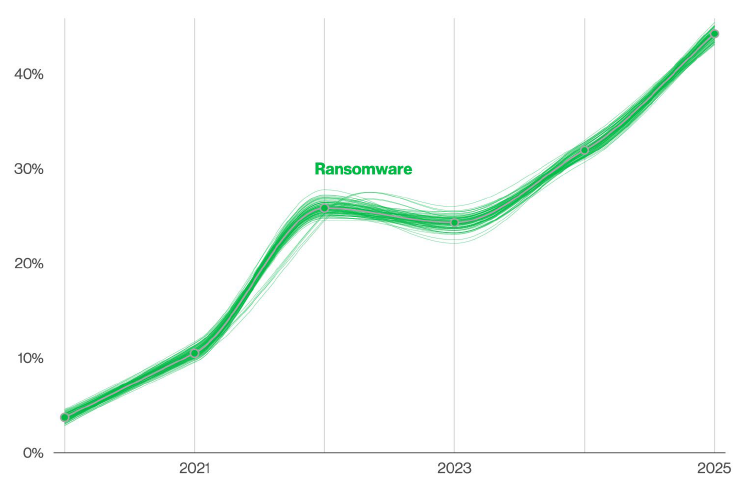
(Ransomware Action Over Time in Breaches (n for 2025 dataset=10,747) – Source: 2025 Verizon Data Breach Investigation Report)
 Third-Party Risk Doubled
Third-Party Risk Doubled
One of the most alarming statistics in this year’s report shows that third-party involvement in breaches has doubled from 15% to 30%. This highlights the critical importance of vetting your suppliers, partners, and vendors as part of your security strategy.
The report identifies several high-profile cases where third-party breaches caused substantial downstream impacts. Notable incidents affected organizations in Healthcare, Retail, and Accommodation and Food Services industries. These breaches not only resulted in data compromise but also caused significant operational disruptions and business interruptions.
The DBIR identifies three primary categories of third-party risk:
- Vulnerable software in your supply chain: Software vulnerabilities introduce risk regardless of who is operating the compromised systems. Organizations need to implement robust patch management programs.
- Partners with access to your environment: Third-party access privileges must be tightly controlled and monitored, as these access points can become entry vectors for attackers.
- Service providers hosting your data: The report highlights cases like the Snowflake breach, where attackers accessed customer data via stolen credentials on a cloud platform that lacked mandatory multi-factor authentication.
A particularly concerning finding relates to leaked secrets in code repositories. The median time to remediate discovered leaked secrets on GitHub repositories was 94 days, creating a large window of exposure for organizations.
 Vulnerability Exploitation on the Rise
Vulnerability Exploitation on the Rise
The exploitation of vulnerabilities as an initial access vector grew by 34%, now accounting for 20% of breaches. This brings it closer to credential abuse (22%) as a primary entry point for attackers.
The report provides detailed analysis of vulnerability management challenges, particularly for edge devices. Among the findings:
- The percentage of VPN and edge device exploitations jumped nearly eight-fold from 3% to 22%
- Organizations fully remediated only 54% of edge device vulnerabilities throughout the year
- It took organizations a median of 32 days to remediate these vulnerabilities
- The median time for vulnerabilities to be mass exploited after disclosure was just 5 days for Common Vulnerabilities and Exposures (CVEs), and alarmingly, zero days for edge device vulnerabilities
The DBIR researchers analyzed data from 10,000 companies that had to remediate vulnerabilities listed in the Cybersecurity Infrastructure and Security Agency (CISA) Known Exploited Vulnerability (KEV) catalog. The findings demonstrated that while edge device vulnerabilities were prioritized more than other types, with higher remediation rates (54% vs. 38% for all KEV vulnerabilities), the response times and completeness remain inadequate given the high risk these exposed systems present.
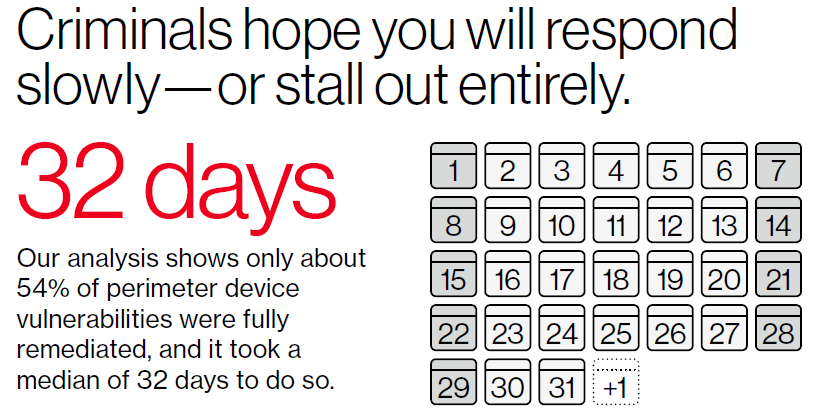
(32 Days to Remediate – Source: 2025 Verizon Data Breach Investigation Report)
 The Human Element Remains Critical
The Human Element Remains Critical
Human involvement in cybersecurity breaches held steady at around 60%. This statistic underscores that despite advances in security technology, humans continue to be a critical factor in security incidents.
These human-element breaches break down into several categories:
- Credential abuse: The use of stolen credentials remains the most common action variety in breaches. Analysis of information stealer malware logs revealed that 30% of compromised systems can be identified as enterprise-licensed devices. More concerning, 46% of those systems with corporate logins in their compromised data were non-managed devices – suggesting significant risks from Bring Your Own Device (BYOD) programs or policy violations.
- Social engineering attacks: Phishing remains prevalent, but the report also highlights the rise of new techniques like “prompt bombing,” where users are bombarded with multi-factor authentication (MFA) login requests until they approve one out of annoyance.
- Human errors: Misdelivery (sending information to the wrong recipient), misconfigurations, and publishing errors continue to cause significant breaches, particularly in sectors like Healthcare and Education.
The DBIR also reveals interesting data about the effectiveness of security awareness training. Organizations with recent training (within 30 days) saw phishing email reporting rates increase to approximately 21%, compared to a base rate of 5% – a fourfold improvement. However, the impact on reducing click rates was much less dramatic, with only about a 5% relative improvement per training.
 AI Adoption and New Threats
AI Adoption and New Threats
The 2025 DBIR provides valuable insights into how artificial intelligence is affecting the cybersecurity landscape. The report notes that AI-assisted malicious emails have doubled over the past two years, indicating that threat actors are leveraging this technology to enhance their attacks.
Platform providers like OpenAI and Google reported attempts by state-sponsored actors to use their tools for influence operations, phishing attempts, and coding activities. While there’s no evidence of revolutionary changes in attack methodologies due to AI, there is a measurable increase in the sophistication and quality of malicious content.
The report also highlights the internal security risks posed by generative AI adoption. Approximately 15% of employees routinely accessed generative AI platforms on their corporate devices, creating new potential data leak vectors. Among these users:
- 72% used non-corporate email addresses as identifiers
- 17% used corporate emails without integrated authentication systems (like SAML)
- Only 11% accessed AI platforms through properly secured corporate authentication
Many common use cases for generative AI – like summarization and coding assistance – involve uploading confidential documents or codebases, creating substantial data leakage risks. The DBIR notes one concrete example: the DeepSeek model was found to be insecurely leaking sensitive data, including chat history, in January 2025.
Industry-Specific Insights
The 2025 DBIR provides detailed analysis for specific sectors, highlighting the unique threat landscapes they face:
 Educational Services
Educational Services
Educational institutions remain highly vulnerable to cyber attacks, with the report analyzing 1,075 incidents and 851 confirmed data breaches in this sector.
- System Intrusion (37%), Miscellaneous Errors (26%), and Social Engineering (17%) represented 80% of breaches
- Ransomware was the most prevalent malware variety, present in 30% of breaches
- The use of stolen credentials was involved in 24% of incidents
- 38% of breaches were caused by internal actors making mistakes, with Misdelivery accounting for 60% of these error-related breaches
- External actors were behind 62% of attacks, with Organized crime groups responsible for 59% of these
- Personal data (58%) and Internal data (49%) were the most commonly compromised data types
The report suggests that educational institutions face sophisticated actors who are willing to put in extra effort to gain access to sensitive data, likely due to the valuable research and personal information these organizations hold, combined with typically less robust security infrastructure.
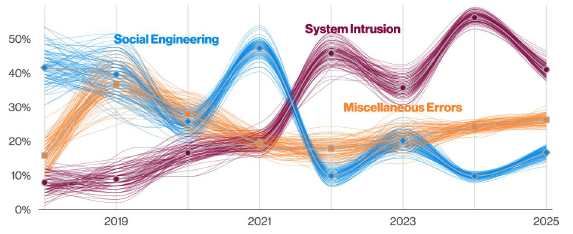
(Top patterns over time in Educational Services breaches – Source: 2025 Verizon Data Breach Investigation Report)
 Healthcare
Healthcare
The Healthcare sector experienced 1,710 incidents with 1,542 confirmed data breaches, showing a slight increase from the previous year.
- System Intrusion has overtaken Miscellaneous Errors as the top pattern, suggesting more sophisticated and deliberate attacks
- Medical data breaches increased, likely tied to ransomware targeting this sector
- Third-party breaches had a major impact, affecting radiology service providers, pharmaceutical firms, IT providers, medical transportation companies, and pharmacies
- The report noted a concerning rise in Espionage as an attack motive, jumping from 1% to 16% of healthcare breaches
- Miscellaneous Errors remained a significant issue, with Misdelivery being the top error variety
The report emphasizes that healthcare organizations need to prepare for “what happens if this partner is attacked” scenarios as part of their security planning, given the high impact of third-party breaches in this sector.
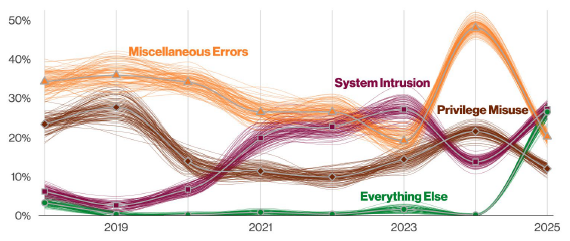
(Top patterns over time in Healthcare breaches – 2025 Verizon Data Breach Investigation Report)
 Manufacturing
Manufacturing
The Manufacturing industry saw a dramatic rise in breaches, with 1,607 confirmed data breaches compared to 849 in the previous year.
- System Intrusion (60%), Social Engineering (22%), and Basic Web Application Attacks (9%) represented 85% of breaches
- Malware actions increased to 66% of breaches, up from around 45% in previous years
- Ransomware was present in 47% of breaches
- Espionage as a motive increased significantly, appearing in 20% of breaches compared to only 3% last year
- Internal data (sensitive plans, reports, emails) was the most commonly stolen data type at 64%
- More than 90% of breached organizations were SMBs with fewer than 1,000 employees
The report suggests that manufacturing organizations face increasingly sophisticated threat actors who are willing to go the extra mile to gain access, potentially seeking both financial gain and intellectual property.
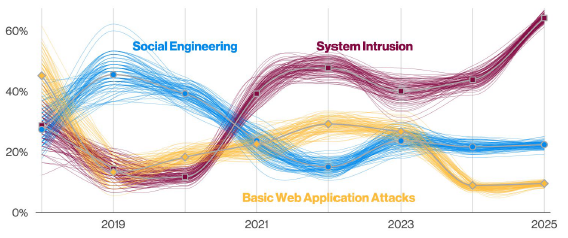
(Top patterns over time in Manufacturing breaches – 2025 Verizon Data Breach Investigation Report)
 Financial Services
Financial Services
The Financial and Insurance vertical continues to be a prime target, with 3,336 incidents and 927 confirmed data breaches.
- System Intrusion, Social Engineering, and Basic Web Application Attacks represented 74% of breaches
- Hacking was the top action type, often leveraging stolen credentials or exploiting vulnerabilities
- Espionage as a motive increased from 5% to 12%, suggesting greater interest from sophisticated threat actors
- Ransomware and credential theft remained the dominant attack vectors
The report notes that the sector attracts both financially motivated criminals and state-sponsored actors, with the latter showing increased interest compared to previous years.

(Top patterns over time in Financial and Insurance breaches – 2025 Verizon Data Breach Investigation Report)
 Small vs. Large Organizations
Small vs. Large Organizations
The 2025 DBIR provides valuable comparative analysis between small and large organizations, revealing significant differences in their threat landscapes:
- Small businesses (fewer than 1,000 employees) experienced nearly four times as many breaches as large organizations, partly due to their greater numbers but also suggesting increased vulnerability
- Small businesses (fewer than 1,000 employees) experienced Ransomware-related breaches at a rate of 88%, compared to only 39% for large organizations
- Both organization sizes saw Use of stolen credentials as the primary hacking variety (32-33%)
- Errors account for 18% of breaches in large organizations but only 1% in small businesses
- Social attacks affected both organization types similarly, with SMBs at 18% and large organizations at 13%
- The majority of actors targeting both types of organizations were financially motivated External actors of the Organized crime variety
The report highlighted a case study of the National Public Data breach in 2024, where a small company with reportedly just a handful of employees experienced a breach that exposed 2.9 billion records containing sensitive personal information of citizens from multiple countries. This illustrates how even small organizations can cause outsized damage when they process large volumes of sensitive data.
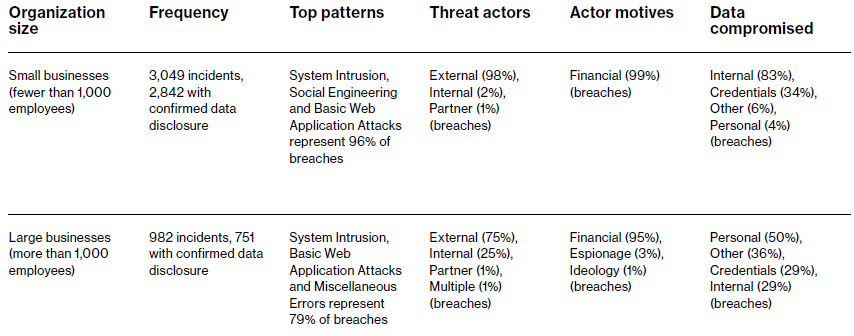
(At-a-glance table by organization size – 2025 Verizon Data Breach Investigation Report)
 How CinchOps Can Help Secure Your Business
How CinchOps Can Help Secure Your Business
With over three decades of IT experience, CinchOps understands these evolving threats and has developed comprehensive solutions tailored to protect businesses of all sizes. We recognize that the statistics presented in the 2025 DBIR aren’t just numbers—they represent real risks to your organization’s operations, reputation, and financial stability.
Our approach to cybersecurity is practical and results-driven:
- Comprehensive Vulnerability Management: We implement proactive patch management and vulnerability assessment systems that prioritize your edge devices and critical infrastructure, addressing the 34% increase in vulnerability exploitation.
- Robust Third-Party Risk Management: Our vendor assessment program helps you identify and mitigate risks from third-party relationships, addressing the concerning doubling of third-party involvement in breaches.
- Multi-layered Ransomware Protection: We deploy advanced endpoint detection, immutable backups, and incident response planning to protect your business against the growing ransomware threat.
- Human-Centric Security: Our security awareness training programs are designed to address the 60% of breaches involving human elements, focusing on recognizing phishing, proper credential management, and secure data handling.
- AI Security Governance: We implement policies and technical controls to manage the risks of generative AI use while allowing your business to benefit from these powerful tools.
Don’t wait until you become another statistic in next year’s DBIR. Contact CinchOps today for a comprehensive security assessment and learn how our managed IT support can strengthen your security posture against today’s sophisticated threats.
Our local expertise in Houston and Katy areas means we understand the specific needs of small and medium businesses in our community, delivering enterprise-grade protection scaled to your requirements and budget.
 Discover More
Discover More 
Discover more about our enterprise-grade and business protecting cybersecurity services: CinchOps Cybersecurity
Discover related topics: Insider Threats: 5 Warning Signs That an Employee May Be Stealing Your Company Data
For Additional Information on this topic: Verizon DBIR: Small Businesses Bearing the Brunt of Ransomware Attacks
![]()
FREE CYBERSECURITY ASSESSMENT



